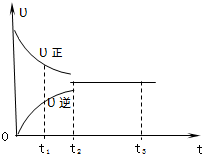问题
选择题
如图是可逆反应X2+3Y2⇌2Z2在反应过程中的反应速率(Ʋ)与时间(t)的关系曲线,下列叙述正确的是( )
A.t1时,只有正方向反应
B.t2时,反应到达限度
C.t2-t3,反应不再发生
D.t2-t3,各物质的百分含量相等

答案
从图象中知:横坐标表示时间、纵坐标表示反应速率.该反应开始时只有X2(g)、Y2(g),
A、0-t1,向正反应方向进行,反应物的浓度不断减少,V正不断减小,同时产物Z2(g)不断增大,V逆由0逐渐增大.故A错误;
B、t2时,V正=V逆≠0,达到平衡状态,即反应到达限度.故B正确;
C、t2时,达到平衡状态,t2-t3,反应未停止,各浓度不变,V正=V逆≠0.故C错误;
D、t2-t3,根据V正=V逆≠0,判断出该反应已达平衡状态,平衡时各物质的浓度不再发生变化,各物质的百分含量不再发生变化,但是各物质的百分含量并不相等.故D错误;
故选B.
